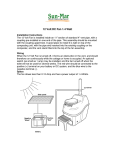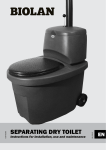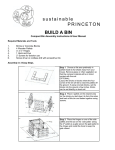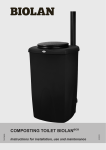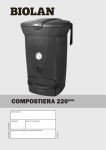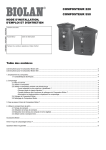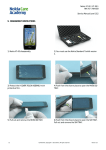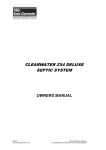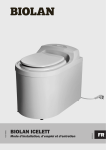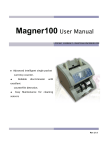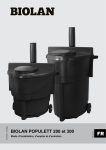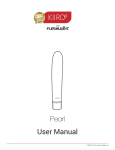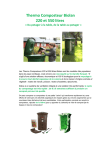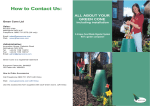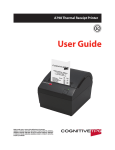Download COMPOSTER BIOLAN 220eco EN
Transcript
Instructions for installation, use and maintenance 01/2012 70579000, 70579200 COMPOSTER BIOLAN 220eco EN 29 cm 31 cm 115 cm 102 cm 62 cm 11 1.5 cm 24 cm 47 cm 80 cm 54 cm 73 cm 54 cm COMPOSTER 220eco Instructions for installation, use and maintenance The Composter Biolan 220eco is a unit intended for year-round composting of kitchen waste. Thanks to the thermo-insulated structure and the efficient ventilation system, ready compost is processed rapidly. You can follow the wonder of composting by monitoring the thermometer and looking through the emptying doorway. The Composter Biolan 220eco is dimensioned for the waste of one family (1-6 persons). Proper use of the Composter Biolan 220eco allows more efficient composting of the mass, and enables more convenient use and emptying of the composter. Contents DimensionsEN-3 Component list EN-4 1. Permissions and regulations applying to composting EN-6 2. Selecting location for the composter EN-6 3. Before use EN-6 3.1 Connecting the seep liquid hose and conducting the liquidEN-6 4. Commissioning EN-6 4.1 Start of the composting process EN-6 5. Using the Composter Biolan 220ecoEN-6 5.1 Filling EN-6 5.2 Emptying EN-7 5.3 To be observed during the cold season EN-7 EN 5.4 Cleaning the Composter Biolan 220ecoEN-7 5.5 Using the air inlet valve EN-7 5.6 Using the air outlet valve EN-7 6. What happens in the Composter Biolan 220eco?EN-7 6.1 Phase of composting EN-7 7. Using the compost and the seep liquid in the garden EN-8 7.1 Using cover soil EN-8 7.2 Maturing cover soil to compost soil EN-8 7.3 Testing the maturity of the compost mould at home EN-8 7.4 Using mature compost mould EN-8 7.5 Using seep liquid EN-8 8. Problems that may occur EN-8 8.1 Smell of decay EN-8 8.2 Smell of ammonia EN-9 8.3 The temperature does not rise EN-9 8.4. The compost mass freezes EN-9 8.5 The compost mass is too tight EN-9 8.6 Flies or their maggots in the composter EN-9 8.7 Ants in the composter EN-9 8.8 Mould in the compost EN-9 8.9 Fungi in the compost EN-9 Disposal of the product EN-9 Biolan accessories EN-10 About the guarantee EN-10 Dimensions volume about 220 l capacity depending on the amount and type for 1-6 people of waste bottom area 54 x 54 cm (w x d) top area 73 x 80 cm (w x d) height of the composter 115 cm working height 102 cm weight of an empty composter about 30 kg weight of a full composter 100-150 kg weight of the cover when opening 3.5 kg diameter of the seep liquid hole 16 mm EN-1 Component list Compo- Part name nent 1 body, green or Part No. Material 17790001 PE + PU 1 body, grey 17790010 PE + PU 2 top, grey 17790002 PE + PU 3 convex sticker 27710360 PE 4 lock bearing 18790004 PE 5 spring wire (for the lock) 21579001 RST 6 lock handle 18790005 PE 7 lead-through rubber 30/40 2 pcs. 19780050 EPDM 8 air outlet valve 18790903 PE outlet valve cover 20040005 PE PP + ST Zn 10 20020005 PP 11 supporter of the cover 18790016 PE 12 hinge pin, 2 pcs. 18790002 PE 13 14 18790003 20010025 PE RST 15 hinge, 2 pcs. ball-headed screw (for the hinge), 2 pcs. emptying door, grey 17790003 PE + PU 16 latch, 2 pcs. and 40580006 17 latch washer, 2 pcs. and 18 latch screw, 2 pcs. 19 liquid separator plate 18710141 PE 20 inlet air valve body 18579001 PE 21 inlet air valve cover 18579003 PE 22 inlet air valve adjuster 18579002 PE 23 thermometer 29726070 RST 24 lower air pipe 18790906 PE 25 intermediate air pipe 18790014 PE 26 upper air pipe 18790905 PE 9 EN PE outlet valve adjuster plastic/metal screw (for the supporter), 2 pcs. plastic nut (for the supporter) Fig. 1: Adjustment of the inlet air valve: arrow to the left = minimum flow EPDM PP RST In addition to the components illustrated in the components picture, the Biolan 220eco also includes: rodent guard (for the seep liquid hole) 21900010 RST filling plug for urethane, grey, 3 pcs. 18790001 PE insert, 3 pcs. 20020016 ST Zn lockhandle screw 20040030 RST name tag 27790010 PE TOP + PP TOP user manual Finnish/Swedish user manual in 10 languages, export products only 27790100 27790110 PAPER PAPER Fig. 2: Adjustment of the inlet air valve: arrow to the right = maximum flow Fig. 3 Tank for collecting seep liquid EN-2 8 7 2 3 4 13 12 14 5 9 6 11 26 10 25 24 1 23 21 22 20 7 19 18 17 16 15 EN Fig. 4 Air outlet valve in the normal position Fig. 5 Air outlet valve in the extra-position EN-3 1. Permissions and regulations applying to composting The permissions and regulations applying to the composting vary from country to country, or even from municipality to municipality. Consult your local municipal environmental authority for the regulations valid in your own municipality. Typically in Finland: • the composter for domestic waste must be thermally insulated, equipped with a cover and protected against rodents. • in some municipalities it is required that the municipal environmental authority or the refuse disposal company be notified about the composting of domestic waste. • mere garden waste can be composted in a non-insulated composter, in a board frame or in a pile. • the compost must be looked after so that no harm is caused to people’s health or to the environment. • the compost must not be placed within 15 metres of a well. • the compost must not be placed within 5 metres of the border of a neighbour without the neighbour’s consent. 2. Selecting location for the composter Place the Composter Biolan 220eco in a location to which waste can easily be taken all year round. Place the composter on a firm surface in a location where water will not gather. Place the composter on a level or incline it slightly to the rear by raising its front edge a little. The Composter Biolan 220eco has a hole in the lower part at the back of the unit for draining off any excessive liquid. Place the composter in direct contact with the ground so that possible seep liquid can be absorbed into the soil. Optionally, you can collect the seep liquid for later use (see point 3.1). If the compost mass is exceptionally wet, some seep liquid can run out from under the emptying door (part 15) or can seep through the air valve in the front wall (part 21). EN 3. Before use Check that the knob of the outlet air valve is in the position "normal", i.e. to the left, as seen from behind the composter. Fix the opening stay for the cover (part 11) in place in the cover using the screw (part 9) and the plastic nut (part 10). Fix its lower end to the body using the screw (part 9). 3.1Connecting the seep liquid hose and conducting the liquid The Composter Biolan 220eco has a hole in the lower part behind the unit, for draining off any excessive liquid to be absorbed into the soil. If you want, you can conduct the seep liquid into a collecting tank, but this is not mandatory. Connect a fabric-reinforced garden hose of 16 mm to the seep liquid hole in the lower part at the back of the unit. Route the hose into a canister that you have placed in such a way that the liquid will flow by gravity alone. If you want, you can build an externally insulated pit with cover of film-faced plywood (as shown in Fig. 3). Any canister made from frost-resistant plastic can be used. You can obtain the canister from the dealer or from Biolan's web store. EN-4 4. Commissioning Put on the bottom a 5 cm-thick layer (about 20 litres) of Biolan Compost and Toilet Bulking Material. Turn the air inlet valve (part 22) in the front wall to the left (see Fig. 1). Start to use the composter as instructed in point 5. Add bedding more generously during the first filling. You can decrease the amount of bedding later. 4.1Start of the composting process The composting process starts as soon as there is a sufficient amount of waste in the composter, i.e. the waste is approximately level with the air channel. The composting process is understood to start when the temperature of the mass inside the composter rises above the outside air temperature. The temperature in the composter is raised and maintained by the vital functions of the micro-organisms that are created in the composter provided that waste is added regularly. The insulation of the composter keeps the heat inside, and prevents the outside air from cooling the mass. In the Composter Biolan 220eco the temperature of the mass varies between +10 – +70 °C. Typically, the reading of the temperature gauge is +30–40 °C. The composting process will, however, proceed at an even lower temperature. Observe the location of the thermometer (part 23) at the upper air pipe (part 26). The thermometer gives indicative information about the various stages of the composting process and the temperature during the hot phase. The hottest part is in the middle, which the thermometer cannot sense. A high temperature indicates the vitality of the micro-organisms. The lower the temperature, the slower the composting process. Composting of the waste will proceed as long as there is a supply of oxygen and the temperature stays above 0 °C. The function of the composter can at best be judged by the quality of the compost being emptied. In a well-functioning composter the compost becomes fully decomposed, except for citrus fruit peels or eggshells that still can be recognisable. After start-up, the waste reaches the cover soil stage in 5-8 weeks. The start-up can be delayed, if the outside air temperature is below 0 °C. if the temperature of the composter is higher than the temperature of the outside air, turn the adjuster of the inlet air valve in the front wall (part 22) to the right. Follow the temperature of the composter and the outside air. If the composter tends to cool after starting up, decrease the setting. 5. Using the Composter Biolan 220eco The composter is intended for biodegradable waste. Do not put into the unit anything that hampers the composting process or does not compost, such as: • plastic, rubber, glass, leather • chemicals, rot-resistant or disinfecting agents, paints, solvents, petrol • detergents, washing water • lime • ash, cigarette butts, matches • vacuum cleaner bags • coloured advertising paper • large amount of paper at one time 5.1Filling • empty the biowaste bin into the composter. The larger the bits you place in the compost, the longer it takes for them to decompose. • if you use biodegradable bags, empty the waste from the bag into the composter and put the bag there separately. • always cover the waste with Biolan Compost and Toilet Bulking Material (see Accessories on page EN-8). A suitable amount is about 1/3–1/2 of the amount of waste added. Use more bedding if the waste is wet. • you can also put the bedding onto the bottom of the biowaste bin. This way the bin will also remain tidy. • Continue the filling at the same pace as the waste is accumulating. If possible, add waste to the composter several times a week. This is particularly important during the cold season. • if the temperature of the composter is higher than the temperature of the outside air, turn the adjuster of the inlet air valve to the figure 100. Follow the temperature of the composter and the outside air. If the compost mass starts cooling down, decrease the setting until the temperature stabilises. • using the Compostmixer (see Accessories on page EN-8), mix the part of the waste added most recently, i.e. the layer about 2030-cm thick from the top. Mixing is not necessary after every time waste is added. The more generously you apply the bedding, the less you need to mix the mass. • do not mix the compost mass down to the bottom, so that the lowest layer that has already cooled down does not cool down the compost mass in the heating phase. 5.2Emptying • The Composter Biolan 220eco must be emptied all year round. Thanks to the oxygen burst, the temperature of the mass often rises in connection with the emptying. Empty the composter, when it is almost full with waste. During the warm season, empty at most half of the total content. During the cold season, empty the composter less frequently, and remove smaller amounts at a time. • open the emptying door (part 15) and empty mass the lower way using spade. • finish using the Emptying Aid (see Accessories on page EN8). Clean in particular the edges of the emptying door and its opening. • also clean under the liquid separator plate (part 19), and make sure that the seep liquid hose is not clogged. • if the mass that you are emptying is very wet, shovel a couple of spadefuls of Biolan Compost and Toilet Bulking Material (see Accessories on page EN-8) on to the bottom of the composter. • close the emptying door. • using the Compostmixer (see Accessories on page EN-8) or the spade, push down the mass from the top. This is easiest to begin from the corners. Be careful not to break the air channel in the middle. • empty the seep liquid receptacle, if necessary. 5.3To be observed during the cold season The heat in the composter is generated by combustion of the waste. The unit itself does not create any heat. The micro-organisms continuously need fresh waste for maintenance of their vital functions. The thermal insulation of the Composter Biolan 220eco prevents the heat from escaping and, by doing so, boosts the operation of the composter and helps prevent it becoming frozen up. • during the cold season, it is important to use the composter, i.e. fill and empty it. This is the only way to create the right conditions for the micro-organisms to be able to maintain a temperature higher than the outside temperature. • do not stop using the composter even though the reading of the thermometer is zero or close to it. • even if the composter's gauge has show zero for a few days, the composter can still contain some non-frozen mass. If the composter fills up, empty it also in winter. • do not reduce the amount of bulking material or stop using it during the cold season, as that’s when using it in large amounts is particularly important. Wet mass freezes more easily. • keep the bulking material in a warm space, and protect it against rain. • check that the circulation of air does not become obstructed if the inlet or outlet valve (part 8 or 21) freezes. Remove any ice as required. • freezing of the mass neither damages the composter or its parts nor harms the compost mass. Decomposing of the compost mass will continue once the sun starts warming things up again in spring. 5.5Using the air inlet valve • if the temperature of the composter is higher than the temperature of the outside air, keep the adjuster of the inlet air valve in the front wall pointing at the figure 100 (see Fig. 2). Follow the temperature of the composter and the outside air. If the compost mass starts to cool down, decrease the setting until the temperature stabilises (see Fig. 1). • during the warm season, you can generally keep the air inlet valve fully open, i.e. in the position 100, and during the cold season, almost closed, i.e. in the position 20 (see Figs. 1. and 2.). • by design the air inlet valve can never be fully closed. In the position 20, 20 % of its holes are open. 5.6 Using the air outlet valve • normally, the air outlet valve (part 8) does not need to be adjusted. It is open, and cannot be closed at all. If the moisturecontent of the composter is high, you can increase the ventilation by opening the valve. • to open the valve, move its knob to the right to the position "extra", i.e. seen from behind the composter (see Figs. 4 and 5). • when using the composter in winter, observe that it may be cooled by the increased ventilation. Keep an eye on the situation. 6. What happens in the Composter Biolan 220eco? The decomposing micro-organisms have three basic needs that have to be fulfilled to enable composting: the presence of oxygen, moisture and nutrients. Oxygen: The micro-organisms need oxygen to survive. To ensure sufficient looseness, mix Biolan Compost and Toilet Bulking Material with the waste (see Accessories on page EN-8). Applying suitable bulking material is essential for proper operation of the composter. The Biolan Compost and Toilet Bulking Material brings about looseness, binds excess moisture and neutralises odours. Branch chaff can also be used for additional looseness. Sawdust, cutter chips, peat, tree leaves and grass are materials which pack up and therefore should not be used as bulking material. Moisture: The micro-organisms of the compost can only survive in a humid environment. The moisture-content is suitable when the mass looks moist and, when clenched in the hand, a few drops of water can be extracted from it. Nutrients: The carbon-nitrogen balance of the compost must be correct. Kitchen waste, green garden waste, manure and urine are sources of nitrogen. Withered brown waste, such as ripened hay, straw, tree leaves and branches contains carbon. Biolan Compost and Toilet Bulking Material (see Accessories on page EN-8) is also rich in carbon. The micro-organisms that decompose the compost use the waste in the compost as well as each other for nutrition. 6.1 Phase of composting Three separate phases can be identified in composting: the warming phase (in the top layer), the hot phase (in the middle) and the cooling phase (in the bottom layer). In the Composter Biolan 220eco all these phases are simultaneously in progress in different layers. 5.4 Cleaning the Composter Biolan 220eco • Do not wash the composter. Various mould and ray fungi and micro-organisms are the decomposers in the compost, and should not be washed away. • Clean the air inlet valve (part 21), the air outlet opening and the seep liquid hose, if necessary. EN-5 EN 7. Using the compost and the seep liquid in the garden The compost makes an excellent soil conditioner, and contains nutrients with a long-lasting effect that are usable for plants. Compost soil changes and develops constantly. It should be used in a different manner in the different stages of its development. Typically compost soil is divided into two groups based on its maturity: cover soil and compost mould. 7.1 Using cover soil The compost emptied from the Composter Biolan 220eco is usually in the cover soil, i.e. in the cooling phase. The decomposing process has reached a level where food waste has already decomposed. The harder wood material, eggshells and citrus fruit peels may not yet be completely decomposed. Therefore, the cover soil has quite a rough look. During the growing season cover soil is applied acover on the ground surface. During the cold season, the compost undergoing the cover soil phase, and to be used in spring, shall be transferred into a composter with a cover or protected by some other means to avoid rainwater flushing away the nutrients. The maturing of cover soil to fully exploitable compost mould takes about 6-12 weeks. This means that the cover soil emptied from the Composter Biolan 220eco after maturing in 6-8 weeks is only suited to covering the growing bed. It needs to be matured more before it can be used for other purposes. It cannot be used as planting or sowing soil or on the most sensitive plants. Raw compost contains substances that hamper germination and growth of the plants. The rich-in-carbon non-decomposed material that it contains also binds the nutrients and oxygen in the soil for use by the decomposing organisms. The cover soil, i.e. the half-mature compost, is not harmful to the plants, if it is spread to cover the planting area of ornamental plants as a layer of a few centimetres. A suitable thickness for the layer to be applied is about 2-5 cm. If you also compost toilet waste mixed with kitchen waste, you can apply it quite normally, in the same manner as cover soil, on the ornamental plants, but compost it for one more year before applying it to edible plants. The intestine-derived bacteria in the toilet waste compost die off when the composting lasts for one year. EN 7.2 Maturing cover soil to compost soil If the cover soil is post-composted, it will mature into proper compost soil. You can post-compost the cover soil, for example, in a stack or in a non-insulated composter, because maturing compost soil does not heat up any longer. For post-composting, it is advisable to use a composter with a cover, such as (e.g.) the Biolan Garden Composter (see Accessories on page EN-8) or the Biolan Stone Composter (see Accessories on page EN-8) to prevent rainwater from flushing away the water-soluble nutrients. Over 6-12 months, the compost matures into compost mould of a dark-brown colour and coarse aggregate structure, in which source substances, except for bigger wood splinters, can no longer be distinguished. 7.3 Testing the maturity of the compost mould at home The maturity of the compost mould can easily be tested at home by sprouting garden cress. 1. Fill two pots: one with compost and the other one with growth peat. 2. Sow the seeds, cover with plastic and place the pots in a sunny place. 3. In two weeks you can judge from the result whether the compost is sufficiently mature or not. If the plants sprout significantly better in the pot with peat, the compost still contains substances that impede growth. The compost is not mature, if the seeds germinate, but the plants soon wither away. EN-6 7.4Using mature compost mould The fertilising effect of the compost depends on its raw materials. Compost created from domestic waste has in general a better nutritive value than compost based on garden waste. Plain compost mould does not make a good growing medium, so it should be mixed with at least 1/3–1/2 of mineral soil, such as for example sand, silt, loam or clay. 7.5 Using seep liquid If you have collected the excess liquid separated from the bottom of the composter via a hose connected to the seep liquid hole in the composter, you can make use of it. This liquid is called "seep liquid" as it has seeped through the compost mass. The seep liquid contains nutrients that the plants can make use of. • for watering garden plants, use the seep liquid diluted in a ratio of at least 1:2. • you can also recycle the seep liquid by pouring it from above into the mass in the Composter Biolan 220eco. Add bedding and absorb at most 5 litres of liquid per day. If the mass is already wet, do not water it further with seep liquid. Please visit www.biolan.fi/composters for more information about composting. 8. Problems that may occur Is the composting not successful? Most of the problems that may be encountered result from using the wrong type of litter. Make sure that the bag bears the label “Biolan”! What is the correct temperature of the compost? In the Composter Biolan 220eco the temperature of the composting mass varies between +10 – +70 °C. Typically, the reading of the temperature gauge is +30-40 °C. The composting process will, however, proceed at an even lower temperature. The less waste the micro-organisms have to decompose, the lower the temperature. The most important prerequisite for keeping the composting process alive is that the mass does not freeze. Only the result (the cover soil) matters – not the temperature at which it has been achieved! 8.1 Smell of decay If the composter smells rotten, the mass is too tightly packed and wet, and has run out of oxygen. • make sure that the bedding used is Biolan Compost and Toilet Bulking Material. • check that you have added a sufficient amount of Biolan Compost and Toilet Bulking Material. • increase the amount of bedding temporarily to bring the moisturecontent under control. • open and empty the biodegradable bags before putting them into the composter. • adjust the outlet air valve (part 8) more open (see point 5.6). • empty wet mass from the composter via the lower way (see point 5.2). Spread it in a layer a couple of centimetres thick under ornamental plants. The unpleasant smell will disappear in a few days. • shovel a couple of spadefuls of Biolan Compost and Toilet Bulking Material through the emptying door (part 15) on the bottom of the composter. • drop the mass from above and mix it with a large amount of Biolan Compost and Toilet Bulking Material. 8.2 Smell of ammonia A pungent smell of ammonia from the composter means that nitrogen is evaporating from the mass. If the nitrogen content is too high compared with the carbon content, the micro-organisms will not have enough time to make use of the nitrogen. • check that no substances with high nitrogen content, such as urine or poultry manure, have been added to the composter. Stop adding excess nitrogen to the composter. • do not add ash or lime into the composter. • make sure that the bedding used is Biolan Compost and Toilet Bulking Material (see Accessories on page EN-8). • check that you have added a sufficient amount of Biolan Compost and Toilet Bulking Material. • increase the amount of bedding added temporarily until the smell disappears. • mix with Compostmixer (see Accessories on page EN-8). 8.3 The temperature does not rise • ensure that the mass is sufficiently moist by looking through the emptying doorway and turning the surface. The moisture-content is suitable => 1. when the composting has not yet started (see point 4.1). Continue the filling as usual. 2. the amount of waste is too small to generate the high temperature required. The waste is burning more slowly. Continue the filling as usual. More decisive than the height of the temperature is whether the waste has enough time to decompose before emptying. If you wish to speed up the composting process, add some nitrogen, such as for example Biolan Natural Fertiliser. 3. the compost has decayed to a point, where the hot phase is already over. Empty some mass from the composter and continue the use. The compost mass is too wet => • make sure that the bedding used is Biolan Compost and Toilet Bulking Material (see Accessories on page EN-8). • check that you have added a sufficient amount of Biolan Compost and Toilet Bulking Material. • adjust the outlet air valve (part 8) in the cover to the position of extra ventilation (see point 5.6). • increase the amount of bedding applied temporarily until the moisture-content is suitable. • empty the wettest part of the mass from the composter through the emptying doorway. Spread it in a layer a couple of centimetres thick under ornamental plants. The unpleasant smell will disappear in a few days. • shovel a couple of spadefuls of Biolan Compost and Toilet Bulking Material through the emptying doorway on the bottom of the composter. • drop the mass from above and mix it with a large amount of Biolan Compost and Toilet Bulking Material. • subsequently, make sure that the mass will not become too wet. The compost mass is too dry => • sprinkle with warm water. • return to the composter the too-dry waste from the bottom after first having sprinkled it. • subsequently, make sure that the mass remains sufficiently moist. 8.6 Flies or their maggots in the composter The compost is more susceptible to the emergence of flies, if the mass is too wet. The fly maggots are about one-centimetre long white worms with black heads. See also point 8.3. • add Biolan Compost and Toilet Bulking Material generously, while simultaneously mixing the compost. In future use the bedding more generously. • turn the surface layer deeper into the compost. The fly maggots die at a temperature of about +43 ºC. • apply a layer about 2 cm thick to the surface. After this, make particularly sure to cover any meat and fish leftovers properly. • rinse the inner walls and the cover of the composter carefully with hot water in order to destroy the eggs and maggots. • as desired, you can do away with the flies using a pyrethrinbased spray. Consult your local garden centre to select a suitable product. 8.7 Ants in the composter The composter provides the ants with feed and a cosy environment, which may make it difficult to keep them away. The ants usually like to stay in the lower part of the composter during the cooling phase. The ants are not harmful to the composting process. • make sure that the composter is not too dry. • you disturb the relative comfort of the ants by emptying small batches of compost regularly. 8.8 Mould in the compost Moulds belong under decomposing organisms of the compost and their existence is quite normal. • do not remove mould. • continue using the composter as usual. 8.9 Fungi in the compost Fungi decompose the wood material in the compost, such as the coarse substance of the bedding, and their presence in the compost is normal. • allow fungi to be present in the compost, as they will disappear with time. • continue using the composter as usual. 8.4 The compost mass freezes • act before the compost mass freezes. Even if the composter's gauge has shown zero for a few days, the composter can still contain some non-frozen mass. If the composter fills up, empty it also in winter. • prevent the freezing by using (filling and emptying) the composter frequently as this maintains the activity of the micro-organisms. See points 5 and 5.1-5.6. Keep the composter quite full in winter and empty it frequently. • pay attention also to the moisture content of the compost mass, as wet mass freezes more easily (see point 8.3). • in winter apply Biolan Compost and Toilet Bulking Material (see Accessories on page EN-8) generously. • to the surface layer of the composter apply gruel mixed from Biolan Natural Fertiliser and warm water. Cover it with bedding. • improve the insulation by piling snow around the composter. • warm the mass by burying, for example, a canister of 10 litres filled with hot water in the top layer and change the water sufficiently often. 8.5 The compost mass is too tight • in winter apply Biolan Compost and Toilet Bulking Material (see Accessories on page EN-8) generously. Mix the bedding and the mass. • Subsequently use the litter more generously, and while filling, make sure that for example grass, rootcrop peels or leaves do not form tight layers. Disposal of the product The raw materials used are presented in the component list (see page 4). Dispose of each part as prescribed. Always follow the regional and collecting-point-specific instructions. To energy-from-waste process or recycling of plastic: EPDM = ethylene propylene PE = polyethylene PP = polypropylene To energy-from-waste process: PU = polyurethane To collection of metal: RST = stainless steel ST Zn = hot-galvanised steel To recycling of paper: Paper EN-7 EN Biolan accessories Availability varies from country to country. Consult your local dealer for details. Biolan Compost and Toilet Bulking Material Biolan Garden Composter Biolan Compost and Toilet Bulking Material is a blend of pure, dried and ground conifer bark, wood and peat for composting and dry toilets. Applying it regularly to the compost keeps the compost mass airy and ensures the composting is efficient and odourless. Package size: a bag of 40 litres, a bag of 85 litres Product number: 40 l 70562100, 85 l 70562500 The Biolan Garden Composter is intended for the composting of domestic, garden and toilet waste in a detached house or a holiday home. Its large, hinged cover makes the filling of the composter easier. The hermetic structure and adjustable air exchange prevent the compost mass from drying, and reduce the need for maintenance. Product number: green 70572000, grey 70576700 Biolan Compoststarter Biolan Stone Composter The Compoststarter is a composting agent manufactured of natural raw materials. The Compoststarter intensifies the composting process and speeds up the decomposing of domestic and garden waste into compost soil with well-balanced nutrient values. Package size: bottle of 1.2 litres, case of 6 litres Product number: 1.2 litres 70535400, 6 litres 70535000 The Biolan Stone Composter is intended for the composting of domestic and garden waste in a detached house or holiday home. Thanks to its large size, it is well-suited to the composting of garden waste and toilet waste from a summer cottage. Biolan Stone Composter having the colour of natural stone merges well with its surroundings, and is well-suited even to small yards. Product number: red granite 70573100, grey granite 70573200 Biolan Compostmixer The Biolan Compostmixer is made of glass fibre-reinforced propene, so it neither corrodes nor oxidises even over time. The Biolan Compostmixer offers effortless mixing of the compost. Product number: 70575200 Biolan Emptying Aid EN The Emptying Aid is an accessory for emptying the composter. Using the aid, you can empty mass even from the most remote corners The Biolan Emptying Aid is made of resilient glass fibrereinforced polypropylene. Product number: 70726310 About the guarantee The Composter Biolan 220eco is guaranteed for five years. 1. The guarantee is valid from the date of purchase and covers possible defects in material and workmanship. The guarantee does not cover any indirect damage. 2. Biolan Oy retains the right to decide about repairing or replacing damaged parts at its discretion. 3. Any damage resulting from careless or forcible handling of the device – from failure to observe the operating instructions, or from normal wear – will not be covered by this guarantee. For matters related to the guarantee, please consult Biolan Oy directly. Biolan Oy P.O. Box 2, FIN-27501 KAUTTUA Tel. +358 2 5491 600 www.biolan.fi EN-8












